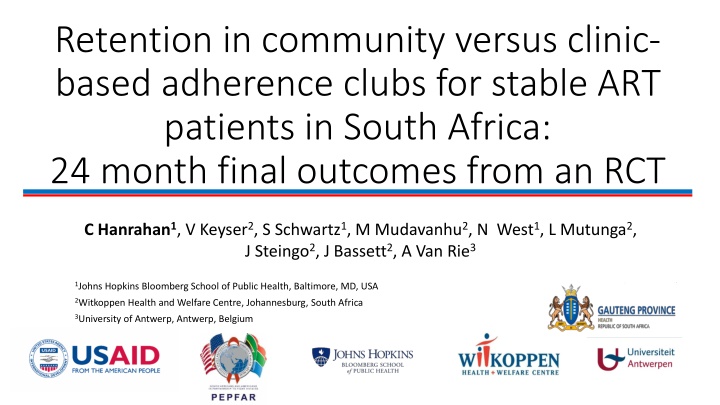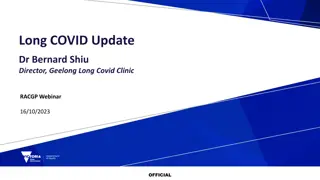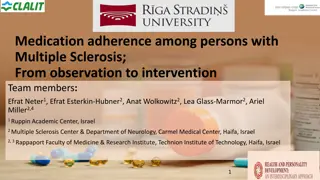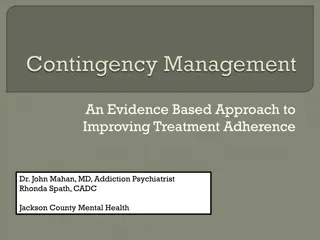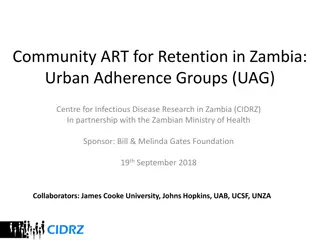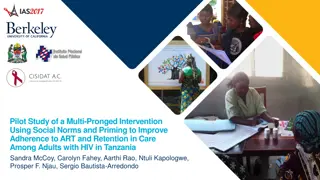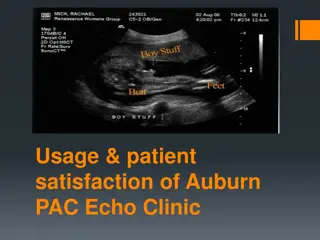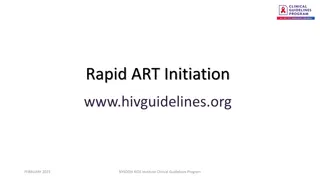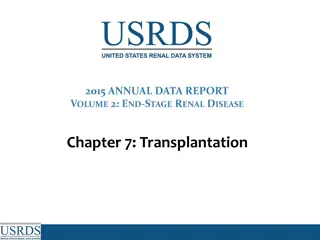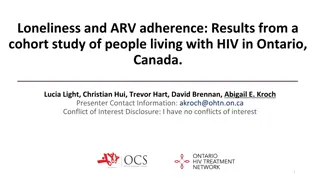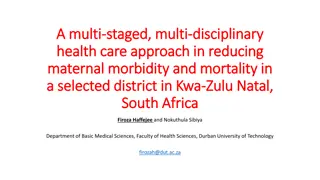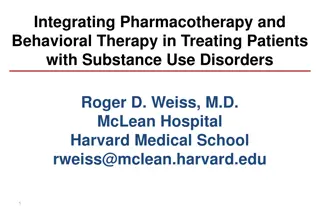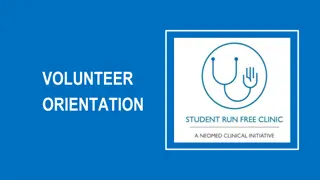Comparison of Community vs Clinic-Based Adherence Clubs for ART Patients in South Africa
This study compares the effectiveness of community-based adherence clubs versus clinic-based clubs in retaining ART patients in care and achieving viral suppression in South Africa. Results from a 24-month randomized controlled trial showed promising outcomes, shedding light on the potential benefits of task-shifting to community-based HIV care. Factors such as stigma, convenience, cost, and access to other health services play a crucial role in patient outcomes.
Download Presentation

Please find below an Image/Link to download the presentation.
The content on the website is provided AS IS for your information and personal use only. It may not be sold, licensed, or shared on other websites without obtaining consent from the author.If you encounter any issues during the download, it is possible that the publisher has removed the file from their server.
You are allowed to download the files provided on this website for personal or commercial use, subject to the condition that they are used lawfully. All files are the property of their respective owners.
The content on the website is provided AS IS for your information and personal use only. It may not be sold, licensed, or shared on other websites without obtaining consent from the author.
E N D
Presentation Transcript
Retention in community versus clinic- based adherence clubs for stable ART patients in South Africa: 24 month final outcomes from an RCT C Hanrahan1, V Keyser2, S Schwartz1, M Mudavanhu2, N West1, L Mutunga2, J Steingo2, J Bassett2, A Van Rie3 1Johns Hopkins Bloomberg School of Public Health, Baltimore, MD, USA 2Witkoppen Health and Welfare Centre, Johannesburg, South Africa 3University of Antwerp, Antwerp, Belgium
Background Adherence clubs Adherence clubs are groups of 25-30 patients stable on ART Patients meet for counselling and medication pickup (~1 hour/2-3 mo) Annual medical visit Facilitate task shifting and decongest busy clinics Experience from 2 observational studies in Cape Town: adherence clubs promote retention in care and viral suppression compared to clinic-based standard of care 57% reduction in loss-to-care (aHR 0.43, 95% CI:0.21-0.91) (Luque-Fernandez 2013) 67% reduction in virologic rebound (aHR 0.33, 95% CI: 0.16-0.67) (Luque-Fernandez 2013) 67% reduction in risk of LTFU (aHR: 0.33, 95% CI: 0.27-0.40) (Grimsrud 2016)
Background Community vs. Clinic-based Clubs Increasing interest in task-shifting to community-based HIV care Systematic review of community versus clinic-based interventions (not specific to adherence clubs) suggest comparable retention and patient outcomes (Nachega, Curr HIV/AIDS Rep, 2016) Factors potentially at play: Stigma Convenience Cost Access to other health care (eg family planning, pediatric care) Others ???
Primary Study Objective Compare the effectiveness of community versus clinic-based adherence clubs on retention in club-based care and viral suppression
Study Design Unblinded, open-label randomized controlled trial Participants were randomized to receive clinic versus community-based club assignment, stratified by area of residence 2 clubs per residential area (1 community, 1 clinic-based) created each month x 12 months starting in Feb 2014 Participants followed up for 24 months
Study Setting Witkoppen Health and Welfare Centre High-volume primary care clinic in northern Johannesburg, South Africa Serves neighboring communities of Diepsloot, Kya Sands, Cosmo City, Fourways and Msawawa (~5-30 mins by public transport) Communities a mixture of informal and formal housing
Intervention Description Based on the MSF model Each club has 25-30 participants Run by a lay HIV counsellor and supported by a Primary Health Care Nurse Meet every 2 months Blood draw every 6 mo, annual medical visit at clinic Screened for pregnancy, TB symptoms and BP (if hypertensive) at each visit Community clubs held at community venues (e.g. community center, churches) Participants were referred back to clinic-based standard of care when: Missing a club visit and no ART pick-up within 5d Viral rebound (a viral load >400 copies/ml or 2 viral loads >50-400 copies/ml) Developing excluding comorbidity requiring clinic-based care Incident pregnancy Sending buddy for pickup 2x in a row Voluntary choice
Inclusion/Exclusion Criteria Inclusion Criteria Exclusion Criteria Age 18 years Currently on D4T containing regimen No change in ART regimen in previous year Currently pregnant or intending to become in 6 mos Virally suppressed for 12 months (confirmed at baseline) Current comorbidity or chronic illness (diabetes, epilepsy, active TB, cancer, mental illness, etc.) Uncontrolled hypertension or treatment with >1 drug Attending clinic with HIV infected child Currently experiencing ART side effects
Definitions and Statistical Methods Primary Outcome Retention in club-based care (including viral suppression) Statistical Methods Primary: Comparison of community versus clinic-based club arms for retention in club-based care using Kaplan-Meier survival curves (log-rank test) Secondary: Univariate and multivariate Cox Proportional Hazards modeling risk of loss from club-based care Robust variance estimator clustered on club
Study Enrollment Files of all ART patients pre-screened daily (~2000/month) Potentially eligible screened by clinician n=1202 Ineligible n=356 (30%) Randomized n=846 (70%) Clinic Club n=412 (49%) Community Club n=434 (51%) Screening failure n=35 (8%) Screening failure n=36 (9%) Community Club n=399 (51%) Clinic Club n=376 (49%)
Study Enrollment Files of all ART patients pre-screened daily (~2000/month) Screened by clinician n=1202 Ineligible n=356 (30%) Randomized n=846 (70%) Not virally suppressed on baseline blood draw Clinic Club n=412 (49%) Community Club n=434 (51%) Screening failure n=35 (8%) Screening failure n=36 (9%) Community Club n=399 (51%) Clinic Club n=376 (49%)
Baseline Participant Characteristics Community Clubs (n=399) 267 (66.9%) 38 yrs (32-43) Clinic-based Clubs (n=376) 239 (63.6%) 38 yrs (33-43) Characteristic Female sex Age, median (IQR) Age category 18-29 years 30-44 years 45+ years Unemployed On FDC Hypertensive Baseline CD4 cells /mm3 (IQR) CD4 category <350 cells/mm3 350-499 cells/mm3 500 cells/mm3 52 (13.0%) 260 (65.2%) 76 (20.2%) 95 (23.9%) 356 (89.2%) 21 (5.3%) 47 (12.5%) 253 (67.3%) 87 (21.8%) 64 (17.1%) 331 (88.0%) 27 (7.2%) 527 (377-690) 472 (342-665) 108 (27.2%) 101 (25.4%) 188 (47.4%) 80 (21.3%) 92 (24.5%) 204 (54.3%)
Primary Outcome: Retention in Club-based Care 24 month proportion retained in club care and virally suppressed: Clinic: 57% (95% CI: 52-62%) Community: 48% (95% CI: 43-53% ) Log-rank test p-value 0.003
Primary Outcome: Retention in Club-based Care 24 month proportion retained in club care and virally suppressed: Clinic: 57% (95% CI: 52-62%) Community: 48% (95% CI: 43-53% ) Overall retention in care and virally suppressed: Log-rank test p-value 0.003 53% (95% CI: 49-62%)
Reasons for Loss From Club-based Care Community club (n=207) Clinic club (n=160) Reason Missing club visit and ART pick-up 120 (58%) 78 (49%) Viral rebound 27 (13%) 33 (21%) Pregnancy 16 (8%) 20 (13%) Other club rule violation 20 (10%) 16 (10%) Voluntarily return to SOC 16 (8%) 9 (5%) Developed comorbidity 6 (3%) 4 (3%) Regimen Change 2 (1%) 0 (0%) 2 p-value 0.180
Risk of Loss from Club-based Care Multivariate* aHR Univariate Characteristic HR p value p value Club Type Clinic Community REF REF 1.36 (1.01-1.86) 0.045 1.44 (1.16-1.80) 0.001 *Multivariate model adjusted for sex, age, employment status and baseline CD4 count.
Retention in Any ART Care & Viral Suppression 24 month proportion retained in Any ART care and virally suppressed: Clinic: 93% (951% CI: 90-95%) Community: 88% (95% CI: 84-91% ) Log-rank test p 0.024
Risk of Loss from Any ART Care/Viral Rebound Multivariate* aHR Univariate Characteristic HR p value p value Club Type Clinic Community REF REF 1.69 (0.98-2.90) 0.057 1.65 (0.96-2.83) 0.070 *Multivariate model adjusted for sex, age, employment status and baseline CD4 count.
Conclusions 24 month retention in club care was higher among participants in clinic-based clubs versus community- based clubs Overall retention in the adherence club intervention was poor (53%) Most common reason for return to SOC was missing club visits Viral rebound and voluntary withdrawal from clubs were rare Retention in care in community-based clubs in this pragmatic trial was much lower compared to published findings from Cape Town This trial: 48% in club-based care, 88% in any ART care Grimsrud, 2016: 94% Luque-Fernandez, 2013: 97% Potential reasons: Differences in timing of outcome assessed (Retention in any ART care vs retention in club-based care) Lack of randomization (Luque-Fernandez: only some stable patients were offered participation, based on the clinician s enthusiasm for the model ) Differences in approach (patient population, eligibility criteria, others?)
Limitations 2 year follow-up is a proxy for what is intended as a life-long intervention Those dropping out of care at study clinic may seek care at another clinic- underestimation of retention in any ART care Unblinded treatment assignment could have led to bias in referral back to standard clinic-based care Generalizability to other settings/countries?
Implications for public health Must be cautious about assuming clinic-based intervention effects carry over into the community Looking at retention within club care is an important outcome A better understanding of which aspects of adherence clubs are associated with success is needed
Acknowledgements Witkoppen Health and Welfare Centre Study participants Elry Rampela Galegole Mokoana Sr. Thobile Mthembu Gauta Moperero Lilian Ngwako Zanele Tshabalala Veronica Modise Collrane Frivold Lavina Ranjan Community Advisory Forum All clinicians Community Partners Gauteng Dept of Health Afrika Tikkun - Diepsloot Department of Social Development Hall- Diepsloot Multi-purpose Hall- Cosmo City Msawawa - Kyasands St. Mungo Church - Bryanston Funding Source USAID Innovations Grant AID-674-A-12-00033 The contents of this presentation are the sole responsibility of Witkoppen Health and Welfare Centre and do not necessarily reflect the views of USAID or the United States Government.
Re-initiation of Standard Clinic-based Care Community Clubs (n=207) Clinic Club (n=160) Period p-value Return to care 60d after last club visit 57% (95% CI: 50-64%) 58% (95% CI:50-66%) 0.848 Return to care 90d after last club visit 72% (95% CI: 65-79%) 73% (95% CI: 65-80%) 0.832
